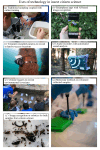Emerging technologies in citizen science and potential for insect monitoring
- PMID: 38705194
- PMCID: PMC11070260
- DOI: 10.1098/rstb.2023.0106
Emerging technologies in citizen science and potential for insect monitoring
Abstract
Emerging technologies are increasingly employed in environmental citizen science projects. This integration offers benefits and opportunities for scientists and participants alike. Citizen science can support large-scale, long-term monitoring of species occurrences, behaviour and interactions. At the same time, technologies can foster participant engagement, regardless of pre-existing taxonomic expertise or experience, and permit new types of data to be collected. Yet, technologies may also create challenges by potentially increasing financial costs, necessitating technological expertise or demanding training of participants. Technology could also reduce people's direct involvement and engagement with nature. In this perspective, we discuss how current technologies have spurred an increase in citizen science projects and how the implementation of emerging technologies in citizen science may enhance scientific impact and public engagement. We show how technology can act as (i) a facilitator of current citizen science and monitoring efforts, (ii) an enabler of new research opportunities, and (iii) a transformer of science, policy and public participation, but could also become (iv) an inhibitor of participation, equity and scientific rigour. Technology is developing fast and promises to provide many exciting opportunities for citizen science and insect monitoring, but while we seize these opportunities, we must remain vigilant against potential risks. This article is part of the theme issue 'Towards a toolkit for global insect biodiversity monitoring'.
Keywords: artificial intelligence; biodiversity monitoring; community science; insects; novel technologies; public participation in scientific research.
Conflict of interest statement
We declare we have no competing interests.
Figures




References
-
- Bonney R, Ballard HL, Jordan RC, McCallie E, Phillips T, Shirk J, Wildermann CC. 2009. Public participation in scientific research: defining the field and assessing its potential for informal science education. Washington, D.C.: Center for Advancement of Informal Science Education.
-
- Irwin A. 1995. Citizen science: A study of people, expertise and sustainable development. London, UK: Routledge.
-
- Roger E, Kellie D, Slatyer C, Brenton P, Torresan O, Wallis E, Zerger A. 2023. Open Access Research Infrastructures are Critical for Improving the Accessibility and Utility of Citizen Science: A Case Study of Australia's National Biodiversity Infrastructure, the Atlas of Living Australia (ALA). Citizen Sci.: Theory Practice 8, 56. (10.5334/cstp.564) - DOI
Publication types
MeSH terms
LinkOut - more resources
Full Text Sources

